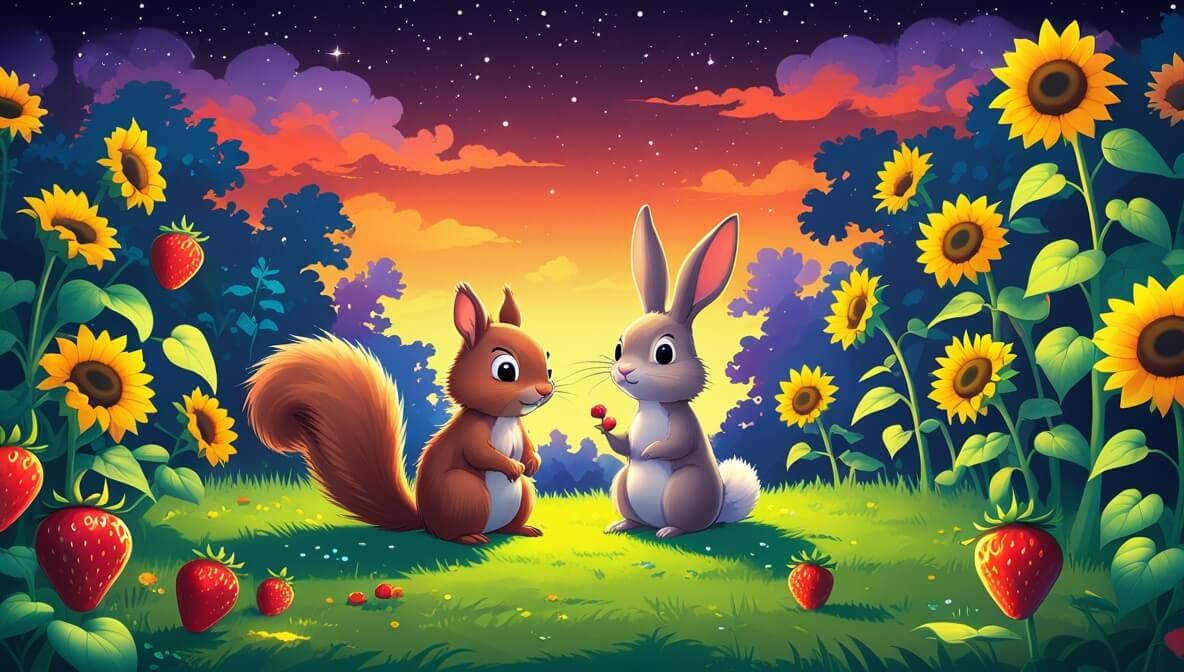In a cozy little town, a curious squirrel and a gentle rabbit discover the magic of friendship under the twinkling stars.
Age Recommendation
0 – 4 years
Characters
Characters:
- Whiskers (a curious and friendly squirrel)
- Hopper (a gentle and kind rabbit)
Story
Once upon a time in a cozy little town, there lived a squirrel named **Whiskers**. Whiskers loved to explore and climb trees, always looking for new adventures. One sunny day, while hopping around, Whiskers met a rabbit named **Hopper**. Hopper was gentle and kind, always ready to help his friends.
The First Meeting
When **Whiskers** saw **Hopper** for the first time, he was excited to make a new friend. “Hello! I’m Whiskers,” he said with a cheerful squeak. **Hopper** smiled and replied, “Hi Whiskers, I’m Hopper. Do you want to play?” They both nodded and decided to **go on an adventure** together.
Adventure in the Garden
Whiskers and Hopper explored the colorful garden nearby. They found **bright red strawberries** and **yellow sunflowers** swaying in the breeze. **Whiskers** climbed up a tree to see the view, while **Hopper** watched from below, giggling at his new friend’s excitement.
Nighttime Magic
As the sun began to set, the sky turned orange and purple. **Whiskers** and **Hopper** sat on a soft patch of grass, watching the stars appear. “Look, Hopper!” said Whiskers. “The **stars are twinkling** just for us!” **Hopper** nodded, feeling happy and safe with his new friend by his side.
The end.
Moral of the Story
Friendship is magical, and sharing moments with friends makes every day special. You never know who you’ll meet and the fun you’ll have when you make a new friend.
Questions to Think About
- What did Whiskers and Hopper find in the garden?
- How did Whiskers and Hopper feel when they saw the stars?
- What makes someone a good friend?
- How can you make a new friend?
- What adventures would you like to have with a friend?
Do You Know
- Rabbits have long ears that help them hear very well.
- Squirrels can jump up to ten times their body length!
Word Explorer
- Adventure: A fun journey or experience.
- Garden: A place where plants and flowers grow.
- Twinkling: Shining with a sparkling light, like stars.
Emotions in the Story
- Excitement: When Whiskers met Hopper and wanted to play.
- Happiness: When they explored the garden together.
- Wonder: As they watched the stars twinkle in the night sky.
Color Your Scene
Imagine Whiskers and Hopper sitting under the twinkling stars. Draw them on a soft patch of green grass, surrounded by colorful flowers. Make the sky a mix of orange and purple as the sun sets.
Parents’ Corner
This story can help parents discuss the importance of friendship and kindness with their children. Encourage your child to think about how being open and friendly can lead to new friendships. Talk about how discovering new things with friends can make experiences more enjoyable and meaningful. Model friendly behavior by introducing your child to new playmates and guiding them through positive interactions.











